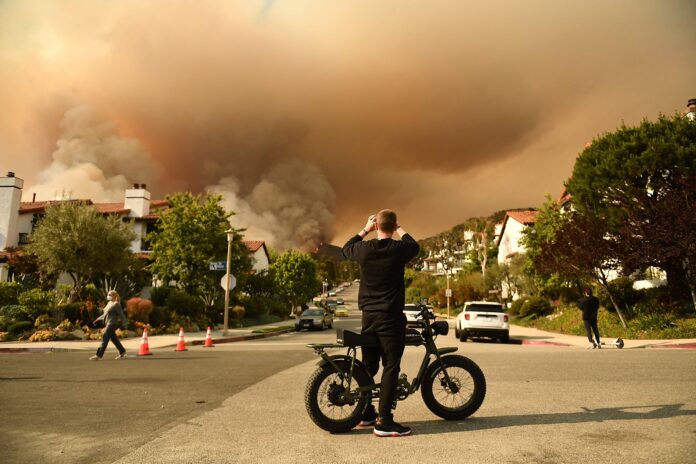
Key Takeaways
- Insurance Companies Did Pull Out: Major insurers, including State Farm, canceled numerous fire insurance policies in Pacific Palisades months before the January 2025 fires.
- Governor Newsom’s “Prophetic Proclamations”? Critics accuse Governor Newsom of having an uncanny knack for declaring states of emergency—sometimes well in advance of unfolding disasters.
- Death and Destruction: At least two people have tragically lost their lives due to the Palisades Fire, while animal fatalities remain unclear. Lack of water, budget cuts to fire departments, and alleged policy missteps have all fueled public outrage.
By Samuel A. Lopez – USA Herald
(Los Angeles, California) 4:10 PM PST – As the Palisades Fire continues to ravage parts of Los Angeles County, a disturbing pattern has emerged: major insurance companies canceled fire insurance policies months before the blaze erupted, leaving many homeowners vulnerable in the face of disaster.
Hello, everyone. Samuel Lopez here from USA Herald. With over 20 years of experience in the legal and insurance sectors, I’ve seen plenty of controversies—but few compare to the heated debates raging in California right now. Wildfires, insurance cancellations, and accusations against Governor Gavin Newsom have created a perfect storm.
State Farm, one of California’s largest insurers, made headlines in the summer of 2024 when it canceled hundreds of homeowners’ policies in Pacific Palisades. The company cited the need to avoid “financial failure” due to the increasing frequency and severity of wildfires in California.
This decision, made just months before the current inferno began on January 7, 2025, has left many residents in a precarious position.
Newsom’s Prophetic Proclamations
Governor Gavin Newsom’s recent string of emergency proclamations has raised eyebrows. His ability to forecast natural disasters with uncanny accuracy has left some wondering how he does it?
On November 6, 2024, Newsom declared a state of emergency for the Mountain Fire in Ventura County, which burned over 8,000 acres. In his proclamation, he stated, “I find that the conditions caused by the Mountain Fire, by reason of their magnitude, are or are likely to be beyond the control of the services, personnel, equipment, and facilities of any single local government and require the combined forces of a mutual aid region or regions to appropriately respond.”
The California Mountain Fire was extinguished on November 27, 2024. It took 22 days to reach 100% containment
Fast forward to January 7, 2025, and Newsom issued another state of emergency proclamation for the Palisades Fire, expanding the scope and geographical area affected. This pattern of preemptive declarations has become a hallmark of Newsom’s administration, though their effectiveness in mitigating disasters remains questionable.
California’s Fire Mitigation Failures – Water Management Controversy
Newsom has also been criticized for his water management decisions. He refused to allow millions of gallons of water, from excess rain and snowmelt from the North, to flow daily into many parts of California, including the areas that are currently burning; instead, Newsom has it running into the pacific ocean.
He wanted to protect the Delta smelt, a small fish native to California, by giving it less water, but this approach did not work.
While environmentalists stress the importance of the Delta smelt to California’s ecosystem, many residents feel the policy overlooked the potential for catastrophic fires and the need to store more water for emergency response.
Critics argue that Newsom’s decisions have led to the current wildfire crisis, with no water for fire hydrants and budget cuts for California Fire Departments around the state.
Photographs and videos from the frontlines show firefighters struggling with water supply, igniting further calls for changes in how California manages its water resources.
Human and Animal Toll
As of now, at least two people have been confirmed dead due to the Palisades Fire. The details surrounding these deaths remain under wraps, likely pending further investigation and notification of next of kin.
On the animal front, official statistics on wildlife and pet fatalities haven’t surfaced. However, numerous local news reports mention the hasty evacuation of pets, livestock, and even some local zoo animals. This uncertainty means the full extent of the fire’s impact on wildlife is yet to be revealed. As someone who’s seen families torn apart by disaster, I can’t overstate the emotional toll that losing a home—or a beloved pet—takes on communities.
Insurance Selective Service
While home insurance policies were canceled due to wildfire concerns, the same insurance companies continued offering other forms of coverage—such as pet, livestock, car, and life insurance—in high-risk areas like Pacific Palisades and Ventura County. This strategy points to a selective withdrawal from the riskiest sector, rather than a complete market exit.
Why remain in these regions? Quite simply, these alternative lines of insurance carry fewer chances of catastrophic payouts compared to homeowners’ policies in wildfire-prone areas. By avoiding the most volatile risks, insurers can still turn a profit through more predictable coverage options.
We’ve all seen the distressing images of burned-out vehicles left behind on Palisades roads by fleeing residents. However, there is a silver lining: the policies not canceled due to fire risks—such as pet, livestock, car, and life insurance—could provide a crucial safety net. These coverages offer a measure of relief for losses like vehicle damage or the medical needs of beloved pets that were caught in the path of the blaze.
California’s Path to Prevention: More Than Just Emergency Proclamations
In the grand scheme of things, prevention may hold the key to curbing these disasters. Lawmakers, environmentalists, and community leaders consistently propose the following:





